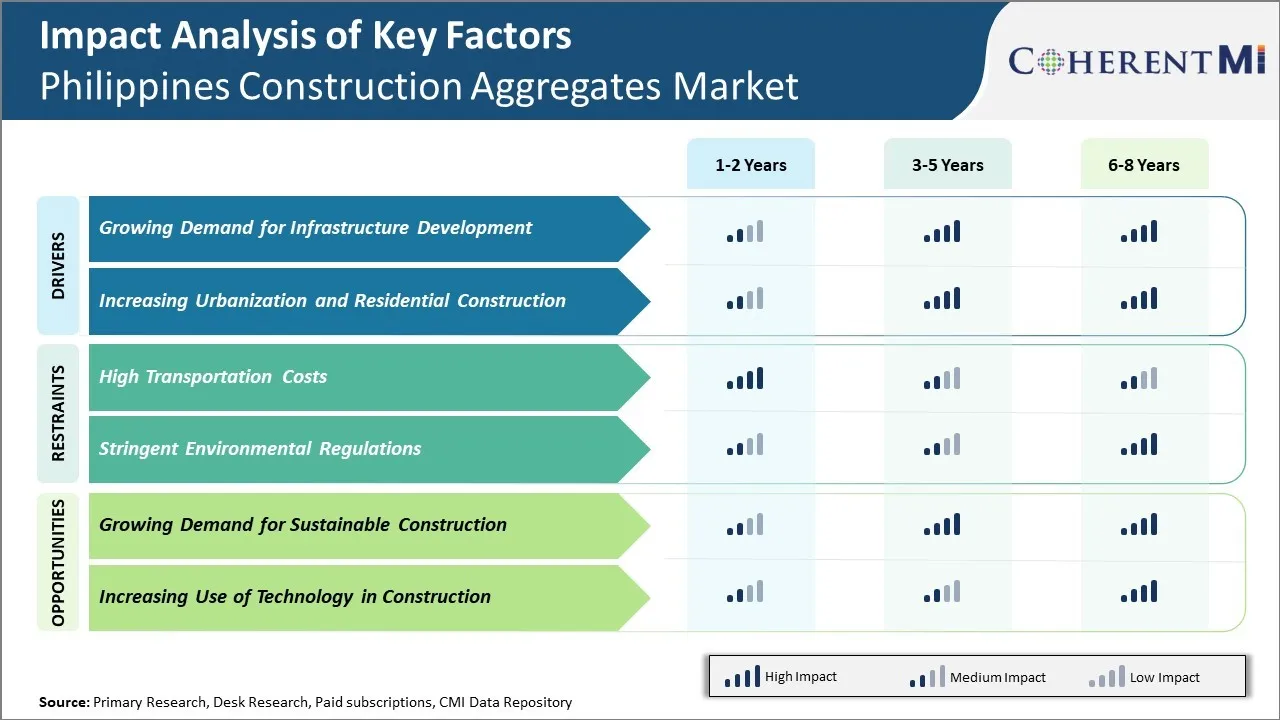Philippines Construction Aggregates Market Trends
Market Driver – Growing Demand for Infrastructure Development
The growing demand for infrastructure development across major cities and regions in the Philippines is one of the key factors positively impacting the growth of the construction aggregates market in the country. The government's massive investments and initiatives to rapidly enhance transportation and connectivity infrastructure are directly translating to increased consumption of crushed stone, sand, and gravel in large volumes.
Recent projects under major programs such as 'Build, Build, Build' and those aimed at strengthening roads, rail, airports and sea ports have significantly lifted the demand for aggregates. For instance, construction activity related to Metro Manila subway project that started in 2020 is using huge amounts of crushed stones and sand on a daily basis. As per Department of Public Works and Highways, the daily requirement of coarse and fine aggregates for the different phases of this single metro project is estimated to be over 10,000 metric tons. This is indicative of the scale of aggregates needed to complete large infrastructure projects of national importance.
Additionally, active developmental projects in different sectors are also propelling the market growth.
Market Driver – Increasing Urbanization and Residential Construction
The rapid urbanization and growth of residential construction in major cities of the Philippines is one of the key factors augmenting the demand for construction aggregates in the country. Over the past decade, there has been a steady migration of people from rural areas to urban centers in search of employment and better livelihood opportunities. This has placed tremendous pressure on the existing housing and infrastructure facilities. As per data from the Philippine Statistics Authority, the urban population in the Philippines grew from 52% in 2015 to over 54% in 2020 and is expected to reach 58% by 2025.
In order to accommodate the burgeoning urban population, local administrations are investing heavily in residential construction activities. For instance, the National Housing Authority has planned to construct over 500,000 housing units across Metro Manila and key urban areas by 2023, as stated in its reports. Similarly, private real estate developers have ongoing projects to develop nearly 1 million new homes during the same period. This rapid growth in housing and residential building development has fueled the demand for quarry materials.

Market Challenge – High Transportation Costs
High transportation costs have significantly restrained the growth of Philippines construction aggregates market in recent years. The Philippines is an archipelago comprising over 7,000 islands, with many construction projects located in remote, isolated areas that are difficult and expensive to access. Transporting heavy construction materials like sand, gravel and crushed stone over long distances to these projects entails high logistic costs. The poor condition of roads and other infrastructure in many parts of the country also leads to higher wear and tear of vehicles, as well as delays during transportation. According to data from the World Bank, the average time taken to transport goods within the Philippines is 203 hours, which is substantially higher than other Southeast Asian countries.
Additionally, the limited availability of suitable modes of transportation in certain parts of the Philippines poses further challenges. Transportation has to rely more on smaller boats or trucks, which have much lesser capacity. This forces more trips to transport equivalent volumes of aggregates. The Philippines Department of Transportation data from 2021 shows that over 60% of municipalities still lack road connectivity, hampering transportation of construction materials even within many islands.
Market Opportunity – Growing Demand for Sustainable Construction
The growing demand for sustainable construction presents a major opportunity for the Philippines construction aggregates market. There is increasing awareness amongst builders, developers and consumers about the need to reduce carbon footprint of infrastructure and building projects. This focuses attention on using construction materials that are environment friendly and sourced through responsible mining practices.
Aggregates form the basic raw material used in cement, concrete and asphalt manufacturing that are indispensable for building activities. The large quantities required make it important to opt for construction aggregates that are sustainably extracted and produced. Mining operations need to follow strict norms for waste disposal, recycling, rehabilitation and ensure minimal damage to land, air and water resources. Aggregates suppliers well-versed with best practices for sustainable sourcing will be better placed to benefit from the shifts in demand.
As the Philippine government works towards limiting greenhouse gas emissions and transitioning to renewable energy as per its commitments under the Paris Agreement, it is formulating more stringent norms for industries. The "Philippine Strategy Towards a Climate Change Resilient and Low Carbon Future" outlined by the Climate Change Commission targets increased investments to upgrade infrastructure and buildings to higher resilience and energy efficiency standards by 2030.